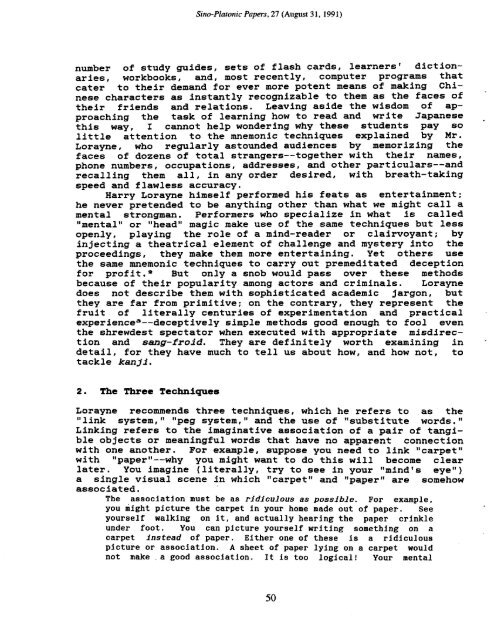Essays on Writing and Language in Honor - Sino-Platonic Papers
Essays on Writing and Language in Honor - Sino-Platonic Papers
Essays on Writing and Language in Honor - Sino-Platonic Papers
You also want an ePaper? Increase the reach of your titles
YUMPU automatically turns print PDFs into web optimized ePapers that Google loves.
Sirlo-Plat<strong>on</strong>ic <strong>Papers</strong>, 27 (August 3 1, 199 1)<br />
number of study guides, sets of flash cards, learnersr dicti<strong>on</strong>-<br />
aries, workbooks, <strong>and</strong>, most recently, computer programs that<br />
cater to their dem<strong>and</strong> for ever more potent means of mak<strong>in</strong>g Chi-<br />
nese characters as <strong>in</strong>stantly recognizable to them as the faces of<br />
their friends <strong>and</strong> relati<strong>on</strong>s. Leav<strong>in</strong>g aside the wisdom of ap-<br />
proach<strong>in</strong>g the task of learn<strong>in</strong>g how to read <strong>and</strong> write Japanese<br />
this way, I cannot help w<strong>on</strong>der<strong>in</strong>g why these students pay so<br />
little attenti<strong>on</strong> to the mnem<strong>on</strong>ic techniques expla<strong>in</strong>ed by Mr.<br />
Lorayne, who regularly astounded audiences by memoriz<strong>in</strong>g the<br />
faces of dozens of total strangers--together with their names,<br />
ph<strong>on</strong>e numbers, occupati<strong>on</strong>s, addresses, <strong>and</strong> other particulars--<strong>and</strong><br />
recall<strong>in</strong>g them all, <strong>in</strong> any order desired, with breath-tak<strong>in</strong>g<br />
speed <strong>and</strong> flawless accuracy.<br />
Harry Lorayne himself performed his feats as enterta<strong>in</strong>ment:<br />
he never pretended to be anyth<strong>in</strong>g other than what we might call a<br />
mental str<strong>on</strong>gman. Performers who specialize <strong>in</strong> what is called<br />
"mentaly1 or "head" magic make use of the same techniques but less<br />
openly, play<strong>in</strong>g the role of a m<strong>in</strong>d-reader or clairvoyant; by<br />
<strong>in</strong>ject<strong>in</strong>g a theatrical element of challenge <strong>and</strong> mystery <strong>in</strong>to the<br />
proceed<strong>in</strong>gs, they make them more enterta<strong>in</strong><strong>in</strong>g. Yet others use<br />
the same mnem<strong>on</strong>ic techniques to carry out premeditated decepti<strong>on</strong><br />
for profit.= But <strong>on</strong>ly a snob would pass over these methods<br />
because of their popularity am<strong>on</strong>g actors <strong>and</strong> crim<strong>in</strong>als. Lorayne<br />
does not describe them with sophisticated academic jarg<strong>on</strong>, but<br />
they are far from primitive; <strong>on</strong> the c<strong>on</strong>trary, they represent the<br />
fruit of literally centuries of experimentati<strong>on</strong> <strong>and</strong> practical<br />
experience3--deceptively simple methods good enough to fool even<br />
the shrewdest spectator when executed with appropriate misdirec-<br />
ti<strong>on</strong> <strong>and</strong> sang-froid. They are def<strong>in</strong>itely worth exam<strong>in</strong><strong>in</strong>g <strong>in</strong><br />
detail, for they have much to tell us about how, <strong>and</strong> how not, to<br />
tackle kanji.<br />
2. The Three Techniques<br />
Lorayne recommends three techniques, which he refers to as the<br />
"l<strong>in</strong>k system, I' "peg system, <strong>and</strong> the use of "substitute words. "<br />
L<strong>in</strong>k<strong>in</strong>g refers to the imag<strong>in</strong>ative associati<strong>on</strong> of a pair of tangi-<br />
ble objects or mean<strong>in</strong>gful words that have no apparent c<strong>on</strong>necti<strong>on</strong><br />
with <strong>on</strong>e another. For example, suppose you need to l<strong>in</strong>k "carpet1'<br />
with llpaperll--why you might want to do this will become clear<br />
later. You imag<strong>in</strong>e (literally, try to see <strong>in</strong> your llmlndls eye")<br />
a s<strong>in</strong>gle visual scene <strong>in</strong> which "carpetn <strong>and</strong> "papern are somehow<br />
associated.<br />
The associatj<strong>on</strong> must be as ridiculous as possible. For example,<br />
you might picture the carpet <strong>in</strong> your home made out of paper. See<br />
yourself walk<strong>in</strong>g <strong>on</strong> it, <strong>and</strong> actually hear<strong>in</strong>g the paper cr<strong>in</strong>kle<br />
under foot. You can picture yourself writlng someth<strong>in</strong>g <strong>on</strong> a<br />
carpet <strong>in</strong>stead of paper. Either <strong>on</strong>e of these is a riddculous<br />
picture or associati<strong>on</strong>. A sheet of paper ly<strong>in</strong>g <strong>on</strong> a carpet would<br />
not make . a good associati<strong>on</strong>. It is too logical! Your mental

















